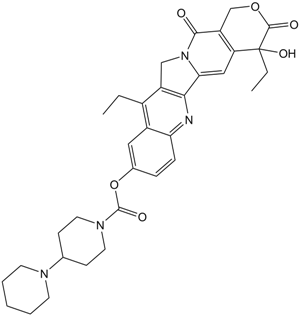Irinotecan |
| Catalog No.GC11473 |
Topoisomerase I inhibitor
Products are for research use only. Not for human use. We do not sell to patients.

Cas No.: 97682-44-5
Sample solution is provided at 25 µL, 10mM.
Irinotecan (CPT-11), a prodrug for treating metastatic colorectal cancer, is a topoisomerase I inhibitor for LoVo cells and HT-29 cells with IC50 of 15.8 μM and 5.17 μM, respectively [1].In vivo, Irinotecan is converted to SN-38, its most active metabolite, by carboxylesterase converting enzyme (CCE) [2].
In vitro: Irinotecan induced similar amounts of cleavable complexes in LoVocells and HT-29 cell lines with the IC50 of 15.8 μM and 5.17 μM, respectively [1].After addition of 157 mM irinotecan to plasma, SN-38 concentration showed linear increase during the first 60-min period, followed by a plateau.In the first 60 min, mean and standard deviation of the conversion rate were 515.9 ± 50.1 pmol/ml/h (n = 69), with a coefficient of variation of 0.097 [2]. Irinotecan (CPT-11) was significantly more active in SCLC than in NSCLCcelllines (P = 0.0036). CE activity appeared to be associated with higher sensitivity to CPT-11 in human lung cancercelllines and may partly explain the difference in the in vitro sensitivity to CPT-11 between SCLC and NSCLCcells [3].In vitro, the sensitivity to CPT-11 and SN-38 was highest in LS174T and COLO 320cells, intermediate in SW1398cellsand lowest in COLO 205 and WiDr cells. The activity of SN-38 was 130 to 570 times than CPT-11[4].
In vivo: In COLO 320 xenografts, Irinotecan induced a maximum growth inhibition of 92% [4].A single dose of Irinotecan significantly increased amounts of topoisomerase I covalently bound to DNA in stomach, duodenum, colon and liver. Concomitantly, the Irinotecan-treated group exihibited significantly higher amounts of DNA strand breaks in colon mucosa cells compared to the control group [5].
References:
[1]. Tobin P, Clarke S, Seale J P, et al. The in vitro metabolism of irinotecan (CPT‐11) by carboxylesterase and β‐glucuronidase in human colorectal tumours[J]. British journal of clinical pharmacology, 2006, 62(1): 122-129.
[2]. Shingyoji M, Takiguchi Y, Watanabe‐Uruma R, et al. In vitro conversion of irinotecan to SN‐38 in human plasma[J]. Cancer science, 2004, 95(6): 537-540.
[3]. van Ark-Otte J, Kedde M A, Van Der Vijgh W J, et al. Determinants of CPT-11 and SN-38 activities in human lung cancer cells[J]. British journal of cancer, 1998, 77(12): 2171.
[4]. Jansen W J M, Zwart B, Hulscher S T M, et al. CPT-11 in human colon-cancer cell lines and xenografts: characterization of cellular sensitivity determinants[J]. International journal of cancer, 1997, 70(3): 335-340.
[5]. Na Y S, Jung K A, Kim S M, et al. The histone deacetylase inhibitor PXD101 increases the efficacy of irinotecan in in vitro and in vivo colon cancer models[J]. Cancer chemotherapy and pharmacology, 2011, 68(2): 389-398.
Average Rating: 5 (Based on Reviews and 22 reference(s) in Google Scholar.)
GLPBIO products are for RESEARCH USE ONLY. Please make sure your review or question is research based.
Required fields are marked with *




